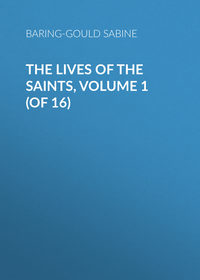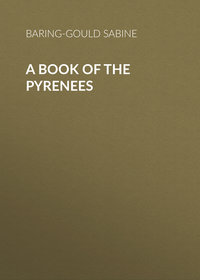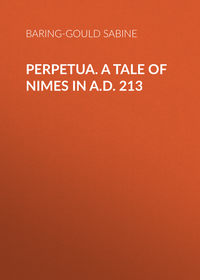 полная версия
полная версияCornish Characters and Strange Events

S. Baring-Gould
Cornish Characters and Strange Events
PREFACE
Cornwall, peopled mainly by Celts, but with an infusion of English blood, stands and always has stood apart from the rest of England, much, but in a less degree, as has Wales. That which brought it into more intimate association with English thought, interests, and progress was the loss of the old Cornish tongue.
The isolation in which Cornwall had stood has tended to develop in it much originality of character; and the wildness of the coast has bred a hardy race of seamen and smugglers; the mineral wealth, moreover, drew thousands of men underground, and the underground life of the mines has a peculiar effect on mind and character: it is cramping in many ways, but it tends to develop a good deal of religious enthusiasm, that occasionally breaks forth in wild forms of fanaticism. Cornwall has produced admirable sailors, men who have won deathless renown in warfare at sea, as "Old Dreadnought" Boscawen, Pellew, Lord Exmouth, etc., and daring and adventurous smugglers, like "The King of Prussia," who combined great religious fervour with entire absence of scruple in the matter of defrauding the king's revenue. It has produced men of science who have made for themselves a world-fame, as Adams the astronomer, and Sir Humphry Davy the chemist; men who have been benefactors to their race, as Henry Trengrouse, Sir Goldsworthy Gurney, and Trevithick. It has sent forth at least one notable painter, the miner's boy Opie, and a dramatist, Samuel Foote, and a great singer in his day, Incledon. But it has not given to literature a great poet. Minor rhymes have been produced in great quantities, but none of great worth. Philosophers have issued from the mines, as Samuel Drew, eccentrics many, as Sir James Tillie, John Knill, and Daniel Gumb. And Cornwall has contributed a certain number of rascals – but fewer in number than almost any other county, if we exclude wreckers and smugglers from the catalogue of rascality.
Strange superstitions have lingered on, and one very curious story of a girl fed for years by fairies has been put on record.
It is somewhat remarkable that Cornwall has produced no musical genius of any note; and yet the Cornishman is akin to the Welshman and the Irishman.
Cornwall has certainly sent up to London and Westminster very able politicians, as Godolphin, Sir William Molesworth, and Sir John Eliot. It furnished Tyburn with a victim – Hugh Peters, the chaplain of Oliver Cromwell, a strange mixture of money-grasping, enthusiasm, and humour.
It has been the object of the author, not to retell the lives of the greatest of the sons of Cornwall, for these lives may be read in the Dictionary of National Biography, but to chronicle the stories of lesser luminaries concerning whom less is known and little is easily accessible. In this way it serves as a companion volume to Devonshire Characters; and Cornwall in no particular falls short of Devonshire in the variety of characters it has sent forth, nor are their stories of less interest.
The author and publisher have to thank many for kind help: Mr. Percy Bate, Mr. T. R. Bolitho, Rev. A. T. Boscawen, Mr. J. A. Bridger, Mr. T. Walter Brimacombe, Mr. A. M. Broadley, Mr. R. P. Chope, Mr. Digby Collins, Mr. J. B. Cornish, Mrs. Coryton of Pentillie Castle, Miss Loveday E. Drake, Mr. E. H. W. Dunkin, f. s.a., Mr. J. D. Enys of Enys, the Rev. Wm. Iago, Mrs. H. Forbes Julian, Mrs. de Lacy Lacy, the Rev. A. H. Malan, Mr. Lewis Melville, Mr. A. H. Norway, Captain Rogers of Penrose, Mr. Thomas Seccombe, Mr. Henry Trengrouse, Mr. W. H. K. Wright, and Mr. Henry Young of Liverpool – and last, but not least, Miss Windeatt Roberts for her admirable Index to the volume.
The publisher wishes me to say that he would much like to discover the whereabouts of a full-length portrait of Sir John Call, with a view of Bodmin Gaol in the background.
S. BARING-GOULD.CORNISH CHARACTERS AND STRANGE EVENTS
WILLIAM PENGELLY, GEOLOGIST
William Pengelly was born at East Looe on January 12th, 1812, and was the son of the captain of a small coasting vessel and nephew of a notorious smuggler. The Pengellys had, in fact, been connected with the sea for several generations. His mother was a Prout of the same family as the famous water-colour artist.
As a child his career was almost cut short by fire. An aunt came to stay with the Pengellys, arriving a day before she was expected. Early on the following morning, when sitting in her bedroom window, wrapped in a thick woollen shawl, she saw her little nephew William rush out of the house enveloped in flames. She hurried after him, and managed to smother the fire with her woollen garment, and thus saved the child's life, though she was herself so badly burnt that she carried the scars to her dying day. The little boy had risen early, and had kindled a fire so that he might go on with his lessons before any one else was astir in the house, with the result that he set light to his clothes, and except for the premature arrival of his aunt, must certainly have been burnt to death.
At the age of twelve he went to sea. He says: —
"Our voyages were short. I do not remember an instance of being at sea more than three consecutive days; so that, except when windbound, we were almost always taking in or taking out cargo. The work was hard, but the food was abundant, and on the whole the life, though rough, was not unpleasant.
"To me – thinking nothing of the pecuniary aspects of the question – the most enjoyable occasions were those which fierce contrary winds brought us, when we had to seek some harbour of refuge. These were by no means necessarily holidays, for, if the weather were dry, advantage was taken of the enforced leisure to give our craft a thorough cleaning, or to repair her rigging, or to make up the books. Moreover, the crew employed me to write letters to their wives from their dictation. These epistles were generally of a remarkable character, and some of them remain firmly fixed in my memory. The foregoing labours disposed of, and foul winds still prevailing, we had a washing day, or, better than all, a bout of tailoring, which did not generally get beyond repairing, though occasionally the ambitious flight of making a pair of trousers was attempted. On tailoring days it was understood that my clothes should be repaired for me, in order that I might read aloud for the general benefit. We assembled in our little cabin, where the stitching and smoking went on simultaneously, and with great vigour. My poor library consisted of a Bible, the eighth volume of the Spectator, Johnson's English Dictionary, a volume of the Weekly Miscellany, the History of John Gilpin, Baron Munchausen's Travels, Walkinghame's Arithmetic, and a book of songs. My hearers were not very fastidious, but allowed me to read pretty much what I pleased, though, truth to tell, the Spectator was not a favourite; some portions of it were held to be nonsensical, and others were considered to be so lacking in truthfulness that it was generally termed the 'lying book.' This ill repute was largely due to the story of Fadlallah (No. 578). Walkinghame was by no means unpopular. I occasionally read some of the questions, and my shipmates endeavoured to solve them mentally; and as the answers were all given by the author, I had to declare who had made the nearest guess, for it was very often but little more. Of all the questions, none excited so much interest as that which asks, What will be the cost of shoeing a horse at a farthing for the first nail, two for the second, and so on in geometrical progression for thirty-two nails, and which gives for the answer a sum but little short of four and a half million pounds sterling. This was so utterly unexpected that it went far to confer on Walkinghame the same name that Fadlallah had given to the Spectator."
William Pengelly tells a curious story of his father, Richard Pengelly: —
"After completing his fifteenth year he was thinking of going to sea. When he was sixteen, his father, who was a sailor, was drowned almost within sight of his home. The effect on the boy was to make him pause, and on his friends, to urge him to give up the idea. For some months these influences kept him quiet, but at length his restlessness returned so strongly, that he would have gone to sea at once, had he felt satisfied that his father would have approved the step. To ascertain this point he prayed frequently and earnestly that his father's spirit might be allowed to appear to him, with a pleasing or frowning aspect, according as he might approve or disapprove. At length he believed his prayer to have been answered, and that when in the field ploughing he saw his father, who passed by looking intently and smilingly at him. This decided him. He became a sailor at seventeen, and as such died at a good old age."
One bitterly cold night at sea, young Pengelly and some other of his shipmates having closed the cabin door, lit a charcoal fire, and speedily fell asleep, succumbing to the fumes of carbonic acid. Happily one of the crew who had been on deck entered the cabin. He found the greatest difficulty in awakening his comrades to sufficient consciousness to enable them to stumble up the ladder to get a breath of fresh air, for their sleep had well-nigh become that of death. The strong and hardy seamen soon recovered, but the boy was so seriously affected that, long after he had been carried upon deck, he could not be roused, and was only restored to consciousness by means of prolonged exertions on the part of his shipmates. His earliest geological experience was made when a sailor-boy weather-bound on the Dorsetshire coast, and he was wont to relate it thus: —
"I received my first lesson in geology at Lyme Regis, very soon after I had entered my teens. A labourer, whom I was observing, accidentally broke a large stone of blue lias and thus disclosed a fine ammonite – the first fossil of any kind that I had ever seen or heard of.
"In reply to my exclamation, 'What's that?' the workman said, with a sneer, 'If you had read your Bible you'd know what 'tis.' 'I have read my Bible. But what has that to do with it?'
"'In the Bible we're told there was once a flood that covered all the world. At that time all the rocks were mud, and the different things that were drowned were buried in it, and there's a snake that was buried that way. There are lots of 'em, and other things besides, in the rocks and stones hereabouts.'
"'A snake! But where's his head?'
"'You must read the Bible, I tell 'ee, and then you'll find out why 'tis that some of the snakes in the rocks ain't got no heads. We're told there, that the seed of the woman shall bruise the serpent's head, that's how 'tis.'"
When in his sixteenth year William Pengelly lost his younger brother, and after that his mother would not suffer him to go to sea. Some years were spent at Looe in self-education.
While still quite young he was induced by a relative of his mother to settle at Torquay, at that time a small place, but rapidly growing and attracting residents to it. Here he opened a small day-school on the Pestalozzian system, and was one of the first to introduce the use of the blackboard and chalk. The school opened with six scholars, but rapidly increased to about seventy.
It was now that scientific studies began to occupy Pengelly's attention, and above all, geology.
In 1837 he married Mary Anne Mudge, whose health was always delicate.
Little by little his renown as a geologist spread, and he did not confine himself to the deposits in Devonshire, but travelled to Scotland and elsewhere to examine the rocks, and to meet and consult with eminent scientists.
In 1846 his private pupils had grown so numerous that he was able to give up his school altogether and become a tutor of mathematics and the natural sciences. He tells a very amusing story of a visit made during holiday time to an old friend.
"I one day learned that my road lay within a couple of miles of the rectory of my old mathematical friend D – . We had been great friends when he was a curate in a distant part of the country, but had not met for several years, during which he had been advanced from a curacy of about £80 to a rectory of £200 per year, and a residence, in a very secluded district. My time was very short, but for 'auld lang syne' I decided to sacrifice a few hours. On reaching the house Mr. and Mrs. D – were fortunately at home, and received me with their wonted kindness.
"The salutations were barely over, when I said —
"'It is now six o'clock; I must reach Wellington tonight, and as it is said to be fully eight miles off, and I am utterly unacquainted with the road, and with the town when I reach it, I cannot remain with you one minute after eight o'clock.'
"'Oh, very well,' said D – , 'then we must improve the shining hour. Jane, my dear, be so good as to order tea.'
"Having said this he left the room. In a few minutes he returned with a book under his arm and his hands filled with writing materials, which he placed on the table. Opening the book, he said —
"'This is Hind's Trigonometry, and here's a lot of examples for practice. Let us see which can do the greatest number of them by eight o'clock. I did most of them many years ago, but I have not looked at them since. Suppose we begin at this one' – which he pointed out – 'and take them as they come. We can drink our tea as we work, so as to lose no time.'
"'All right,' said I; though it was certainly not the object for which I had come out of my road.
"Accordingly we set to work. No words passed between us; the servant brought in the tray, Mrs. D – handed us our tea, which we drank now and then, and the time flew on rapidly. At length, finding it to be a quarter to eight —
"'We must stop,' said I, 'for in a quarter of an hour I must be on my road.'
"'Very well. Let us see how our answers agree with those of the author.'
"It proved that he had correctly solved one more than I had. This point settled, I said 'Good-bye.'
"'Good-bye. Do come again as soon as you can. The farmers know nothing whatever about Trigonometry.'
"We parted at the rectory door, and have never met since; nor shall we ever do so more, as his decease occurred several years ago. During my long walk to Wellington my mind was chiefly occupied with the mental isolation of a rural clergyman."
In 1851 he lost his wife, and some years after both his children by her.
In 1853 he married a Lydia Spriggs, a Quakeress.
William Pengelly's scientific explorations may be divided under three heads. The first was his minute and accurate examination of the deposits that form Bovey Heathfield, where there are layers of clay, sand, and lignite. He was able to extract numerous fossil plants, and thereby to determine the approximate age of the beds.
Next he took up the exploration of ossiferous caves; and he began this work with that of Brixham, in Windmill Hill.
The floor of this cavern was excavated in successive stages or layers, starting from the entrance. Bones were found in the stalagmite and in the first, third, and fourth beds, and worked flints in the third and fourth beds only; but where the third bed filled the cavern up to the rock, its upper portion contained neither bones nor flints. The bones were those of the mammoth, the rhinoceros, the urus, hyæna, cave lion and cave bear, etc.
But by far the most laborious scientific undertaking of Pengelly's life was the exploration of Kent's Cavern, near Torquay. This cave was known as far back as 1824, when a Mr. Northmore, of Cleve, near Exeter, made a superficial examination of it to ascertain whether it had been a temple of Mithras, and quite satisfied himself on this point. He was followed by Sir W. C. Trevelyan and by the Rev. J. MacEnery. But it was not till 1865 that a complete, scientific, and exhaustive exploration was undertaken by the British Association, which made a grant of £100 for the purpose. Mr. Pengelly was appointed secretary and reporter to the committee for the examination of the cave and its deposits.
It was found that the floor of the cave exhibited the following succession: (1) Blocks of limestone sometimes large, clearly fallen from the roof. (2) A layer of black mould ranging from a few inches to upwards of a foot in depth. (3) Beneath this came a floor of granular stalagmite, about a foot in thickness, formed by the drip of water from the roof. (4) A red loam containing a number of limestone fragments. (5) A breccia of angular fragments of limestone and pebbles and sandstone embedded in a reddish sandy calcareous paste.
On June 19th, 1880, the exploration of Kent's Hole was brought to an end. It was the most complete and systematic investigation of a cavern that had ever been undertaken, and on a much greater scale than that at Brixham. A task of this kind is peculiarly exacting. It cannot be entrusted to workmen; it cannot be left to a committee whose members pay but intermittent visits: it demands the constant oversight of one man; and this superintendence was given to Pengelly. The total amount spent on this exploration was £2000. Pengelly states in one of his papers that in the fifteen and a quarter years during which the excavation was in progress he visited Kent's Hole almost daily, and spent over the work, on an average, five hours a day.
"Above the stalagmite, and principally in the black mould, have been found a number of relics belonging to different periods, such as socketed celts, and a socketed knife of bronze, and some small fragments of roughly smelted copper, about four hundred flint flakes, cores, and chips, a polishing stone, a ring (made of Kimmeridge clay), numerous spindle whorls, bone instruments terminating in comb-like ends, pottery, marine shells, numerous mammalian bones of existing species, and some human bones, on which it has been thought there are traces indicative of cannibalism. Some of the pottery is distinctly Roman in character; but many of the objects belong, no doubt, to pre-Roman times."
What was found beneath the stalagmite belonged to a long anterior period, where it had lain sealed up for, at the very least, two thousand years. In this deposit of the cave earth were found a large number of chips, flakes, and implements of flint and chert, stones that had served as pounders, and some pins, needles, and harpoons of bone.
Some mammoth bones were found in Kent's Cavern, and those of the cave lion, the sabre-toothed tiger, the glutton, cave bear, woolly rhinoceros, horse, reindeer, and beaver.
Mr. W. Pengelly died on March 17th, 1894.
A writer in the Transactions of the Devonshire Association for 1894 says: "For science he lived, and for science he laboured, even long after the age when the average man seeks rest and quiet. Starting out in original lines of thought, and untrammelled by traditions of years long ago, he met with many rebuffs, and the conclusions which he derived from his investigations and minute and patient inquiry were almost laughed to scorn. But he adhered to his work and clung to his beliefs, with enthusiastic devotion, and in the end he lived to see even those who had originally stoutly opposed his views convinced of their verity, and their inestimable value to archæological and geological science."
Pengelly himself left this piece of advice to the student: —
"Be careful in scientific inquiries that you get a sufficient number of perfectly trustworthy facts; that you interpret them with the aid of a rigorous logic; that on suitable occasions you have courage enough to avow your convictions; and don't be impatient, or annoyed, if your friends don't receive all your conclusions, or even if they call you bad names."
It must be remembered that Pengelly and Sir Charles Lyell were those who startled English minds with the revelation of the enormous period of time in which man had lived on the earth, and of the slow progression of man through vast ages in the development of civilization. How that he began with the rudest flint implements, and progressed but very slowly to the perfection of these stone tools; how that only in comparatively recent times did he discover the use of metals and pottery; how of metals he first employed bronze, and not till long after acquired the art of smelting iron and fashioning tools and weapons of iron. All this startled the world, and men were very unwilling to accept the doctrine propounded and to acknowledge the facts on which this doctrine was based.
The Life of William Pengelly was written by his daughter Hester Pengelly, and published by Murray, 1897. Reference has been made as well to the obituary notice in the Transactions of the Devonshire Association for 1894.
SIR CHARLES WILLS, K.B
Sir Charles Wills belonged to a very ancient and widely ramified family in Cornwall. The first, however, of whom anything authentic is known was Anthony Wills, of Saltash, who died in 1576. They were settled at Landrake, at Morval, Botusfleming, Wyvelscombe, Exeter, and Gorran.
Anthony Wills, of Gorran, youngest son of Digory Wills, of Botusfleming, had a son, Anthony Wills, who was the father of the Right Hon. Sir Charles Wills, k. b., general of His Majesty's forces, baptized at Gorran 23rd October, 1666. Sir Charles had two brothers, Richard, of Acombe, in the county of York, and Anthony, of the Inner Temple, who died in Ireland 1689. The arms of the family are, arg. three griffins passant, in pale, sa., within a bordure engrailed of the last besantée.
Sir Charles was a subaltern in 1693, when serving in the Low Countries under William III. The King went to Holland at the end of March in that year, and returned on the last day of October, when the armies went into winter quarters. Wills was in the battle of Landen and at the siege of Namur. On the 13th October, 1705, he was appointed colonel of the 30th Regiment, and sailed with it to Spain. He acted as quartermaster-general to the troops in that country, was present at Llenda, Almanza, and Saragossa, and was made prisoner in 1711 with the army under General Stanhope, but was released at the end of the war.
He had been appointed brigadier-general in 1707, major-general on 1st January, 1709, and lieutenant-general 16th November, 1710. After the peace of 1715, being in command of the troops in the Midland district, he marched northwards to meet the rebels from Scotland, and he and General Carpenter met them at Preston. Preston was a town both Jacobite and Roman Catholic; and in it was the army of the Pretender, composed of Scottish Highlanders and Lancashire gentry and their retainers.
General Carpenter, who had been marching into Scotland, turned back into Northumberland, and by forced marches had reached Durham, where he combined with General Wills, who had been sent some time before into the north to quell the many riots that preluded the insurrection.
Wills concentrated six regiments of cavalry, for the most part newly raised, but commanded by experienced officers, at Manchester, whence he moved to Wigan. There it was arranged that Wills should march straight upon Preston, while Carpenter, advancing in another direction, should take the insurgents in flank. As the Hanoverians approached, General Forster, who commanded the Jacobites, gave satisfactory evidence that he was no soldier; he fell into a fright and confusion, and betook himself to bed. But Lord Kenmure roused him, and in a hurried council, where all the gentlemen had a voice, and where those spoke loudest who knew least of war, a plan of defending Preston was adopted. But the plan, at least as executed, consisted merely in throwing up some barricades in the streets and in posting some men in defence of them. Brigadier Mackintosh either knew not the ground or his better judgment was overruled; for Preston offered many advantages as a defensive position which were altogether neglected. In front of the town was a bridge over the Ribble, that might have been held by a handful of men, and from the bridge to the town, for a distance of a mile, the road ran through a hollow between steep banks for a mile. But river, bridge, and road were all left undefended. When Wills rode up to the bridge and saw that it was unprotected he could hardly believe his eyes; and then he concluded that the insurgents must have abandoned Preston and begun their retreat into Scotland, so that there would be no fighting that day.









